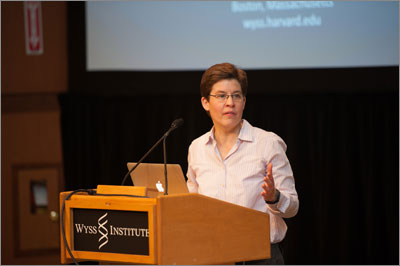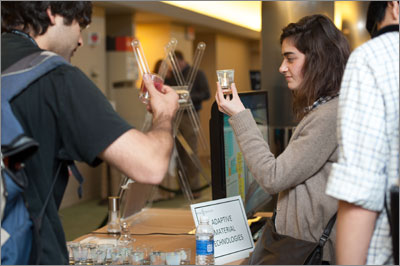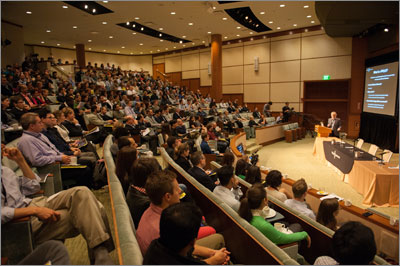In just five short years, the Wyss Institute has produced a torrent of innovative technology, and nowhere was that more in evidence than at the Institute’s annual retreat, held November 18 at Boston’s Seaport World Trade Center.
"Making this Institute fly in five years has been like pulling a rabbit out of a hat, and we birthed one heck of a rabbit," Don Ingber, M.D., Ph.D., Wyss Institute Founding Director, said in opening remarks to the packed crowd. More than 500 members of the Institute community, including Institute benefactor Hansjörg Wyss, attended the retreat.

Since its launch in 2009, the Wyss Institute has grown into a vibrant community with a unique mission: to build materials and devices the way nature builds to transform healthcare and the environment.
But the Institute does not just do science, report the results, and leave it to others to commercialize technology. Instead, it moves new inventions down the so-called technology pipeline — translating the most promising ideas into product prototypes by investigating market needs; collaborating with clinicians and companies, and, with Harvard’s Office and Technology Development, orchestrating an effort to develop licensing agreements and start-ups built around these new breakthroughs. In its five years, Institute researchers have published more than 600 publications and filed more than 640 patent applications.
"We’re going to have a pipeline for a while," Ingber said.
One technology that has sped through the pipeline uses nanoparticles to deliver a clot-busting drug directly to blockages in blood vessels to treat pulmonary embolism, stroke, atherosclerosis, and more, said Mary Tolikas, Ph.D., MBA, the Institute’s operations director, in her keynote address on the Wyss’s technology translation model.
Tolikas described how a Wyss Institute team led by Netanel Korin, Ph.D. a former Wyss Technology Development Fellow and Ingber conceived a precision drug-delivery system inspired by the body’s plateletsthat delivers small doses of clot-busting drugs directly to blocked areas in blood vessels, greatly reducing dangerous side effects from internal bleeding.
In July 2012, they reported in Science that the system dissolved blood clots, saving mice from death by pulmonary embolism. But they didn’t stop there. They brainstormed potential clinical applications – stroke, heart attack, and atherosclerosis, among others. Patents were filed, and an entrepreneur was brought in house to help the business development team choose among different ways to commercialize the technology.
The team then talked with pharma companies, investors, and clinicians; found out which medical conditions were most ripe for a new treatment, and worked with Institute technical staff to overcome remaining technical hurdles that might discourage a company from commercializing the technology.
"This is just one example of the translation path that our technologies are taking," Tolikas said.

Meanwhile, other technologies emerging from the Institute’s six Enabling Technology Platforms, such as synthetic biology and anticipatory medical devices, are simultaneously speeding toward licensing to both large corporations and new startups via the Institute’s unique translation model. These include SLIPS, an ultraslippery material pioneered by Institute Core Faculty member Joanna Aizenberg that repels almost any liquid, even under harsh conditions, and a versatile new fluorescent probe invented by Core Faculty member Peng Yin that helps scientists better spot DNA or RNA in cells.
That sort of success comes from hard work, but also from play, Tolikas said. "The Wyss Institute is a fun playground where we all come to work every day and have out-of-the-box ideas that can explode into multiple opportunities," Tolikas said. "We have the audacity to dream big dreams."
Throughout the day, the convention center resembled a science museum, with teams from the Institute’s different Platforms demonstrating their latest and greatest inventions — a vibrating mattress to prevent premature babies from dying of sleep apnea; crawling termite-like robots that could lay sandbags to stop the spread of floodwaters; a microfluidic-based pathogen capture system to prevent food poisoning and expensive food recalls, and new window materials that could shine sunlight deep into offices, pleasing workers and conserving energy.
Audience members also heard from the Institute’s platform leaders. Members of the Institute’s synthetic biology platform, which is led by George Church, Ph.D., Core Faculty member of the Institute, described new tools to engineer living cells, edit genomes, evolve new cellular pathways to mass-produce vitamins, antibiotics and biofuels, and even engineer a solar-powered bionic leaf that could one day replace oil.
Core Faculty member David Mooney, Ph.D., who leads the Programmable Nanomaterials Platform, described how his team had developed a biodegradable plastic sponge the size of a baby aspirin tablet that reprograms the immune system to fight cancer. The team filed with the U.S. Food and Drug Administration (FDA) to test the experimental drug in human clinical trials in January 2013. The FDA quickly approved it, and the Wyss team is now collaborating with clinicians at the Dana-Farber Cancer Institute to test it in melanoma patients.
The work of the platform "is a testimony to the creative faculty, advanced technology staff, and collaborating faculty," Mooney said.
Such success is also a product of a carefully cultivated culture of innovation at the Wyss, Ingber said. "What we’re all about is doing visionary high-risk research while spanning the academic-industry divide," he remarked.

After a day celebrating technology translation, Jennifer Lewis, Sc.D., the newest Core Faculty member at the Wyss Institute, capped off the intellectual feast by describing how new advances in 3D printing could spur new invention and transform the future of manufacturing.
Unlike current manufacturing methods, which require expensive dyes, molds, and lithographic masks, soon scientists and manufacturers will be able to 3D print a wide variety of useful devices, using computer-aided design (CAD) and special inks, including those Lewis is inventing.
"Whatever you can CAD, with 3D-printing now you can build," said Lewis, who is also the first Hansjörg Wyss Professor of Biologically Inspired Engineering at Harvard’s School of Engineering and Applied Sciences.
To keep up the progress, Ingber called for the entire Wyss community to brainstorm toward the future. "To continue our success, we will need to continuously reinvent ourselves to do high-risk work and explore new directions," he said.
But the possibilities are tremendous, and people are noticing. Pointing to the widespread media coverage the Institute has received, Ingber remarked: "The extent of this news coverage means that the average person cares about what we’re doing. This means that we’re closer to the people we’re trying to impact – and that I’m very proud of."